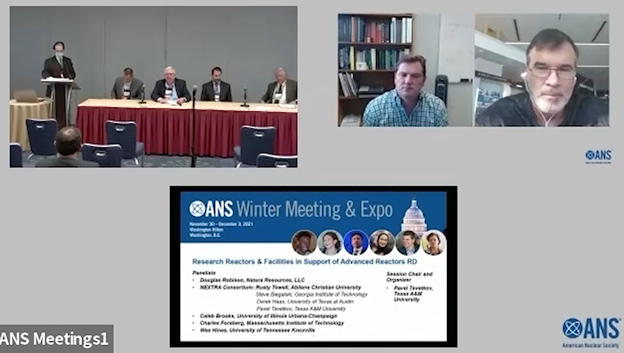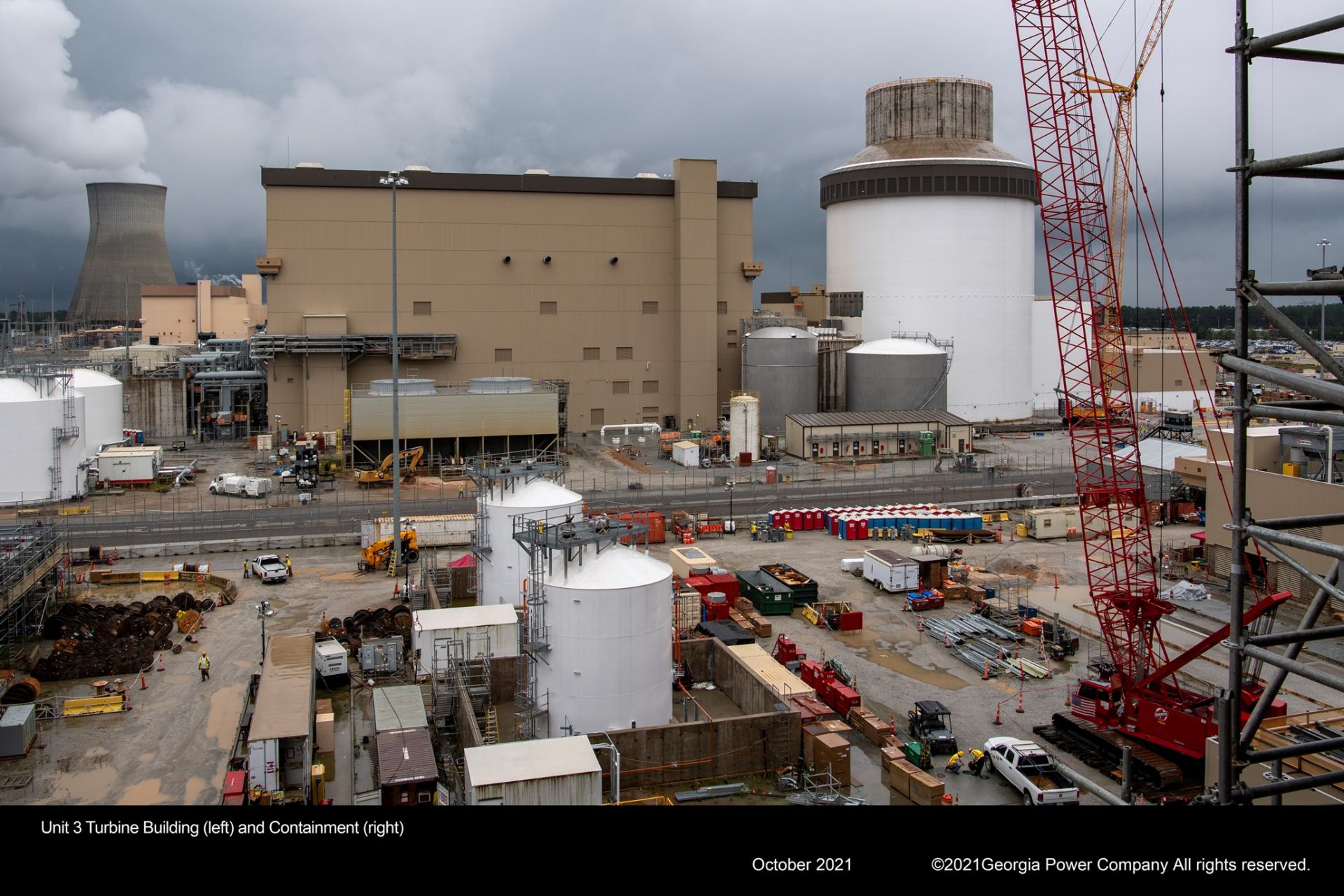A screen shot from the “Research Reactors in Support of Advanced Reactor R&D” session at the 2021 ANS Winter Meeting and Technology Expo.
First-of-a-kind research reactors, demo reactors, and research facilities are being developed and sited on university campuses to support the broader deployment of advanced reactors. At the 2021 ANS Winter Meeting and Technology Expo, during a December 2 panel session titled “Research Reactors in Support of Advanced Reactor R&D,” several of these planned projects were discussed in detail—including a molten salt reactor in Texas and a high-temperature gas–cooled reactor in Illinois.
The session was sponsored by the Reactor Physics Division and organized and chaired by Pavel Tsvetkov, of Texas A&M University. A video of the session is available to registered Winter Meeting attendees.
Crews take down the Load-In Facility at the West Valley Demonstration Project. The demolition is scheduled for completion early next year. (Photo: DOE)
The Department of Energy’s Office of Environmental Management (EM) is set to complete the 69th building demolition at the West Valley Demonstration Project early next year, when crews finish knocking down the last structure standing that supported operations at the former Main Plant Process Building.
Click to see full image. Concept art for the NUWARD small modular reactor. (Image: TechnicAtome)
Électricité de France recently announced the formation of an advisory board for NUWARD, France’s small modular reactor project. According to the company, the establishment of the International NUWARD Advisory Board (INAB) is a major step forward in support of the technology’s development.
A screen capture from the meeting that discussed the pathway to net-zero emissions by 2050: (From left) Leah Parks, Giulia Bisconti, Nicholas McMurray, Josh Freed, and Laura Hermann. Panelists who joined the meeting virtually were Sama Bilbao y León and Edie Greaves.
The Thursday morning executive session at last week’s 2021 ANS Winter Meeting and Technology Expo brought together a group of influential nuclear-policy experts from the United States and abroad to discuss the roles nuclear can play in smoothing the pathway to net-zero emissions by 2050. Specific topics explored included the Clean Energy Ministerial (CEM) and its Nuclear Innovation Clean Energy (NICE) Future initiative, as well as last month’s COP26 climate conference in Glasgow. The session was moderated by Leah Parks, a Nuclear Regulatory Commission risk analyst and 2020 ANS Presidential Citation awardee.
Vogtle Units 3 (in foreground) and 4, in November. (Photo: Georgia Power)
Georgia Power has revised the projected commercial operation dates for Vogtle-3 and -4 a total of four times this year—most recently in October—but some experts are saying that at least one more delay is probable.
The Hunterston B nuclear power station in 2018. (Photo: Thomas Nugent/CC BY-SA 2.0)
Unit B1 at Scotland’s two-unit Hunterston B nuclear power plant was taken off line for good on November 26 after nearly 46 years of operation. A 490-MWe advanced gas-cooled reactor, the unit entered commercial operation in June 1976. Its companion AGR, Unit B2, which entered operation in March 1977, is scheduled for retirement in January.
Artist’s rendering of a BWRX-300 plant. (Photo: GE Hitachi Nuclear Energy)
Ontario Power Generation (OPG) has selected GE Hitachi Nuclear Energy (GEH) as its technology partner for the Darlington nuclear new-build project. The companies will work to deploy GEH’s BWRX-300 small modular reactor at OPG’s Darlington nuclear plant, located in Clarington, Ontario.
Jamie Weaver with the neutron depth profiling instrument. (Photo: T. Barvitskie/NIST)
The newest generation of lithium-ion batteries now being developed uses thin-film, solid-state technology and could soon safely power cell phones, electric vehicles, laptops, and other devices. However, like all batteries, solid-state lithium-ion batteries have a drawback: Impedance—electrical resistance—can build up as batteries are discharged and recharged, limiting the flow of electric current.
The Vogtle-3 turbine building (left) and containment (right) in October. (Photo: Georgia Power)
The Nuclear Regulatory Commission will increase its oversight of Vogtle-3—one of the two Westinghouse AP1000 reactors under construction at the Vogtle nuclear power plant in Waynesboro, Ga.—after finalizing two inspection findings involving the unit’s safety-related electrical cable raceway system. Vogtle’s operator, Southern Nuclear, was informed of the decision in a November 17 letter.
The agency had launched a special inspection at Vogtle-3 in June of this year to determine the cause and extent of construction quality issues in the raceway system, which consists primarily of conduits and cable trays designed to prevent a single event from disabling redundant safety-related equipment.
SwRI engineers used LIDAR point cloud data to reconstruct a high-resolution image of a facility that houses electric turbines at the nuclear power plant. 3D cubes, or voxels, on the left provide spatial information on the turbine facility. Point clouds were reconstructed to create the high-resolution image of the turbines on the right. SwRI specializes in data visualizations to identify damage and potential hazards following accidents at nuclear power plants and other hazardous facilities. (Graphic: SwRI)
During the EnRicH 2021 European Robotics Hackathon, Southwest Research Institute’s unmanned aircraft system (UAS or drone) explored and mapped the interior of a nuclear power plant, detecting radiation sources autonomously, without the aid of a human pilot.
SwRI’s UAS technology can potentially assist in life-saving search-and-rescue missions and hazardous inspections at industrial facilities and infrastructure following natural disasters and other incidents.













 and containment (right).jpg)
